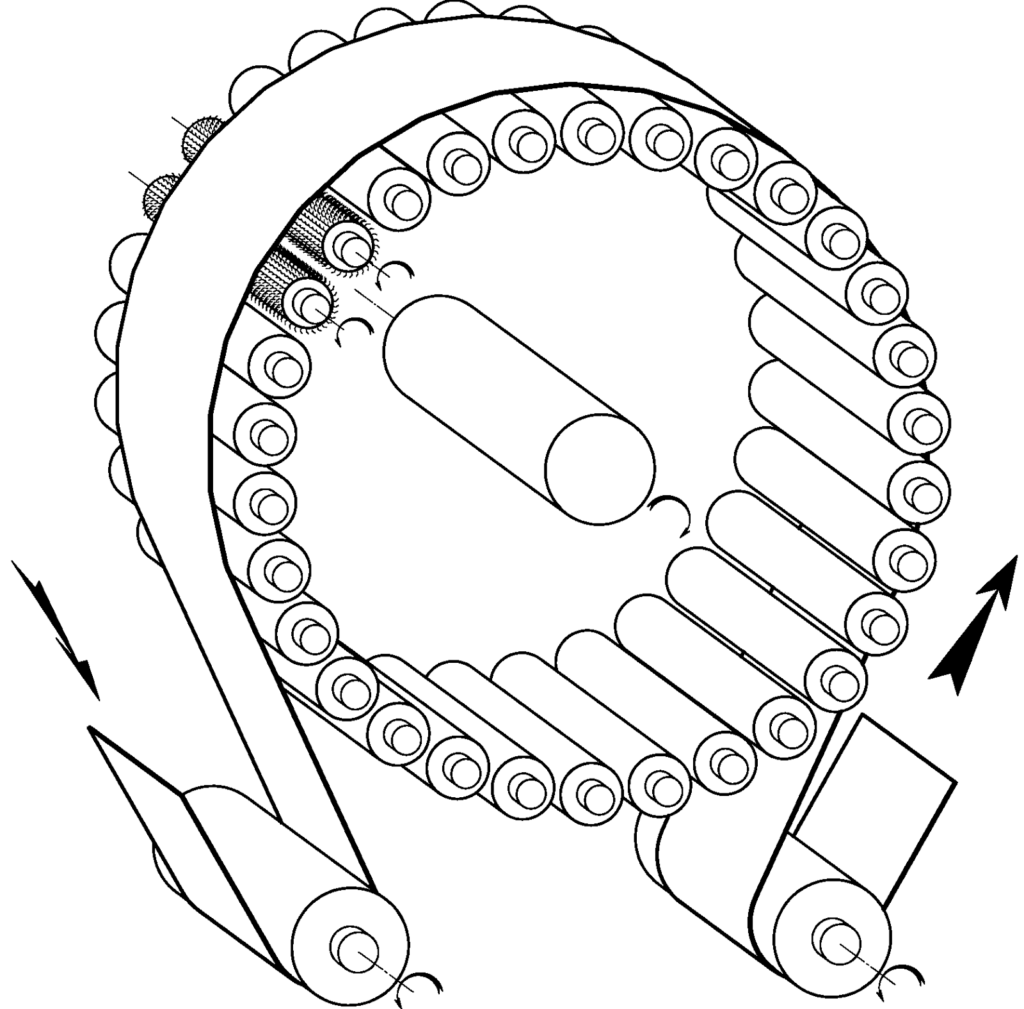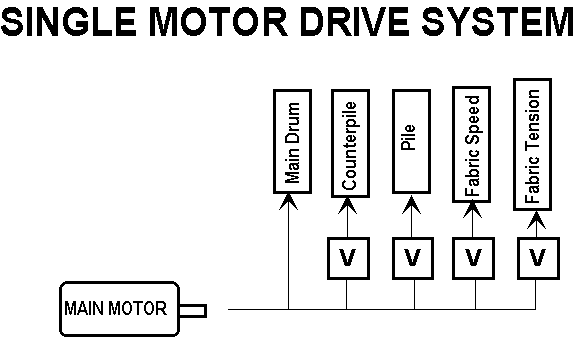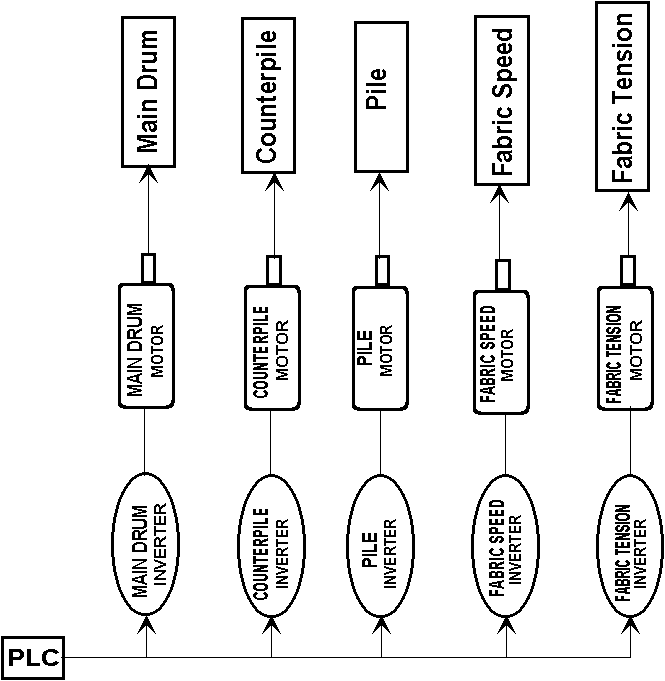Technology of raising ITA
The function of a raising machine is to produce a hairy surface on a fabric, this effect is made through a series of needles that, with a mechanism that we will explain later, are penetrating the fibres, breaking and lifting them.
To better understand the function of the raising machine we should refer to the geometric figure of the epicycloid, which is a plane curve produced by tracing the path of a chosen point on the circumference of a circle, called an epicycle, which rolls around a fixed circle.
The scheme of a raising machine can be seen in drawing on the right; a series of rollers, that are called raising rollers, are placed on a flange with circular settlement, these rollers are covered by an ordered alignment of needles. The raising rollers are divided between “pile” and “counterpile” raising rollers, according to the direction which the needles are plied.
It is now easy to find the similitude with epicycloid when we consider the points of the raising fillet, the raising rollers that roll on their axle and that are supported on flanges that are rotating on their center.
The scheme of a raising machine can be seen in drawing on the right; a series of rollers, that are called raising rollers, are placed on a flange with circular settlement, these rollers are covered by an ordered alignment of needles. The raising rollers are divided between “pile” and “counterpile” raising rollers, according to the direction which the needles are plied.
It is now easy to find the similitude with epicycloid when we consider the points of the raising fillet, the raising rollers that roll on their axle and that are supported on flanges that are rotating on their center.
The raising rollers are rotating on their axle, both series of pile and counterpile are rotating in the same direction.
The flange on which the raising rollers are fixed is also rotating on its axle.
The assembly of raising rollers fixed on two side flanges is called “main drum”.
The fabric encircles and is sliding on most of the raising drum; it enters in one point that is called fabric entry, in this point a driven roller (called tension roller) is controlling the feeding of the fabric on the main drum.
The fabric leaves the main drum, pulled out by a roller called fabric speed roller, this roller in fact is controlling the sliding speed of the fabric on the main drum.
To resume, in a raising machine we have 5 different axles:
- Main Drum
- Counterpile Raising rollers
- Pile Raising rollers
- Fabric tension
- Fabric Speed
When we are talking about planetary raising machines, the developments that have been seen in the history of raising machines, have not changed much in the final configuration of a modern raising machine.
The real development has happened in the drive of the raising machine, in the last 30 years we have seen several developments that were following what the technology was putting at our disposal, in terms of drive systems.
The characteristic of drive in a raising machines, that have always given headache to designers are :
1. A wide range in the speed variation (50 – 600 rpm and 500-2000 rpm)
2. High torque at low speed.
3. Negative drive in case of Pile axle.
4. Perfect synchronisation between the 5 axles.
Until the late ‘80s the raising machines have mainly featured a centralised drive: one motor was driving the whole machine and the drive was transmitted to the 5 axles. Some speed variation devices, were changing the speed of each axle.
This system was ensuring a perfect synchronization of the 5 axles; being them chained mechanically we could be sure that start, running and stop, were perfectly synchronized.
This system had as a negative aspect, a narrow range of variation and a limited capacity to transmit high torque.
The big change in the drive of the raising machines was anyhow in the ‘80s: with the eve of DC motors first and AC motors with inverters at a later time; the raising machine drive had a complete change.
One motor for each axle and an electronic system to synchronize the start, stop and speed variation of the five axles.
At the beginning the motors used was mainly DC motors; the electronic was not yet so sophisticate and the simpler drives for DC motors were more reliable of the Inverters, that in the ‘80s had big dimensions and low efficiency.
Today the AC motors with inverters are offering us the best solution for the drive of a raising machine.
The three phase motor (AC motor) is a very simple machine, which is also very strong, it needs very limited maintenance and can perform well also under high stress applications.
The high technology level reached by the inverters has made them very reliable, able to drive the AC motor in a very precise way and with a very good torque.
The fact of having an independent drive for each axle, introduces us to new functions and to an higher flexibility in the raising machine operation; the latest technologies in electronic controls, are boosting this possibility even more.
The first advantages are of cost-saving type:
- Having all the motors driven by inverters, eliminates the effect of phase displacement in the 3-phase electric current, which is consuming un-necessary electric energy.
- Each single motor will absorb only the power he requires; it is in fact normal that the installed power in a raising machine with inverter’s drive is much higher than it’s average consumed power.
- Reducing the number of mechanical transmission, the efficiency of the machine is higher and is possible to have higher powers.
The system explained above is the most common and used for the majority of fabrics, anyhow there are some types of fabrics that request different configuration of the raising fillet, according to the type of fabric to be processed :
Characterized by raising fillet in straight and counterpile direction. The raising drum rotates against the fabric. This is an old style of raising, mainly used in old oil drive raising machines. Today has been replaced by the conventional pile/counterpile configuration.
Characterized by a raising drum with all counterpile rollers. It is used after the raising operation to put down the pile and make like a felting operation, that makes the fabric look like a felt. Used in some types of knitted fabrics, such as fleece and for the reverse of polar fleece.
Characterized by a raising drum with all pile rollers. It is used after the raising operation to comb the pile of the fabric and open it to prepare it for a correct shearing. Particularly useful for the antipilling operation. For the best results our company has made the combined combing and shearing machine RS5000 which has the advantage of making a combined action resulting in an incomparable quality.
The double drum machine has introduced several advantages in the field of raising machines, first of all thanks to the optimization of space and labor given by having 2 machines in the space of one machine. Moreover the double drum raising machine introduced also additional functions and flexibility to the raising machine concept.
Having 2 drums one on top of the other, in the same machine allows to have additional functions like:
- Raising two times the same face
- Raising one time the face and one time the reverse of the fabric
But this is not all, thanks to the fact that the raising drums can rotate in both directions, and can be configured differently, it is possible to have reverse rotation of the raising drum or to have the two raising drums with different configuration, like All Counterpile, Knit Goods Napper and so on.






